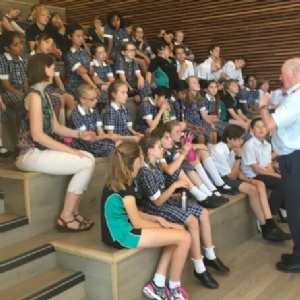
Inspire and Guide lecture by Professor Malcolm Longair
Published on 04/07/18

Year 6 round off the year in a truly inspiring and out-of-this-world manner!
On Friday 29 June we had the privilege of welcoming an extremely eminent speaker to present the last in the series of Junior Inspire talks to our Year 6 pupils for this academic year. Professor Malcolm Longair is a distinguished astronomer, whose positions have included Astronomer Royal for Scotland, Director of the Royal Observatory, Edinburgh and head of Cambridge University’s Cavendish Laboratory, where he is still very much active as Emeritus Jacksonian Professor of Natural Philosophy. His talk was entitled ‘Black Holes and Gravitational Waves Made Simple’ - an ambitious title you might think, but it turned out that if anyone could do it, this was the man!
Professor Longair took us on a highly energetic whistle-stop tour of the natural history of stars and galaxies: how they are born, live and die. This included covering the whole of Einstein’ special and general relativity in two slides! We learned that the mass of a star has important implications for how it will collapse when it runs out of fuel for nuclear fusion, with the most dramatic outcome being the formation of a black hole. The nature of these mysterious entities was explained in clear terms by getting the young audience to first get to grips with the concept of ‘space-time’, which Professor Longair had them repeating several times in a quick-fire way, which they found highly amusing! Gravity was explained as a bending of curved space-time, with a black hole representing the most extreme level of distortion, such that not even light can escape from it.
A highlight of the talk was a demonstration of a set of ‘gravitational lenses’ which Professor Longair has had constructed at the Cavendish Laboratory. These have been designed to an exact specification, which allows them to mimic precisely the bending of light from distant galaxies by massive objects in the intervening space between them and the Earth. The lenses represented different kinds of galaxies and a black hole. There were audible ‘wows’ from the audience as he moved each of the lenses on front of various background pictures, including a grid representing space-time, different shapes and Hubble Telescope images of actual galaxies. The pictures were distorted into strange and beautiful shapes, including arcs and full circles. The truly astonishing leap was then to see real telescope images showing actual examples of these ‘gravitational lensing’ effects: a powerful vindication of Einstein’s predictions.
Professor Longair concluded the lecture by discussing gravitational waves: how they were predicted by Einstein, how they are generated by cataclysmic cosmic events and the kinds of massive, highly sensitive apparatus needed to detect them. We were even able to see and hear some real-time recordings of actual gravitational waves.
The young audience was clearly captivated by what they saw and heard throughout the talk, and a number of them were inspired to ask thoughtful and searching questions, which revealed an impressive level of existing knowledge. Understandably, many of these focused on black holes: what is their effect on our planet, how we know they are there if we can’t see them, what is their density and what lies beyond the ‘event horizon’? On a more personal level, Professor Longair was asked what made him become an astronomer: he said he had initially become interested in Physics, later on developing a more specialist interest in astronomy. He said he hoped the lecture may have played some role in encouraging them to follow a similar career path.
We are most grateful to Professor Longair for taking time out of his busy international schedule to come and speak to Year 6, rounding off the year in a truly inspiring and out-of-this-world manner!
by Mr Gordon West
